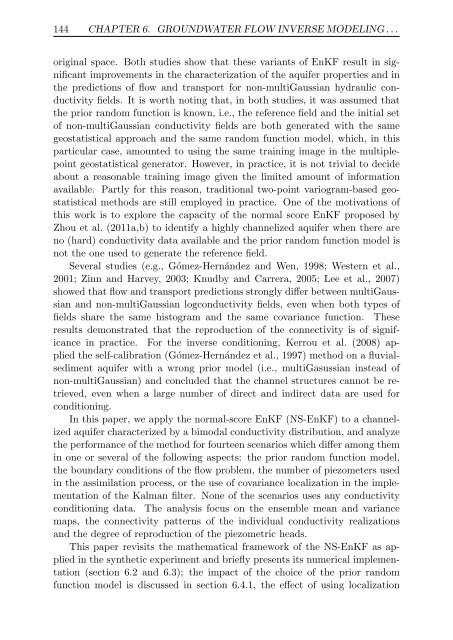Upscaling and Inverse Modeling of Groundwater Flow and Mass ...
Upscaling and Inverse Modeling of Groundwater Flow and Mass ...
Upscaling and Inverse Modeling of Groundwater Flow and Mass ...
You also want an ePaper? Increase the reach of your titles
YUMPU automatically turns print PDFs into web optimized ePapers that Google loves.
144 CHAPTER 6. GROUNDWATER FLOW INVERSE MODELING . . .<br />
original space. Both studies show that these variants <strong>of</strong> EnKF result in significant<br />
improvements in the characterization <strong>of</strong> the aquifer properties <strong>and</strong> in<br />
the predictions <strong>of</strong> flow <strong>and</strong> transport for non-multiGaussian hydraulic conductivity<br />
fields. It is worth noting that, in both studies, it was assumed that<br />
the prior r<strong>and</strong>om function is known, i.e., the reference field <strong>and</strong> the initial set<br />
<strong>of</strong> non-multiGaussian conductivity fields are both generated with the same<br />
geostatistical approach <strong>and</strong> the same r<strong>and</strong>om function model, which, in this<br />
particular case, amounted to using the same training image in the multiplepoint<br />
geostatistical generator. However, in practice, it is not trivial to decide<br />
about a reasonable training image given the limited amount <strong>of</strong> information<br />
available. Partly for this reason, traditional two-point variogram-based geostatistical<br />
methods are still employed in practice. One <strong>of</strong> the motivations <strong>of</strong><br />
this work is to explore the capacity <strong>of</strong> the normal score EnKF proposed by<br />
Zhou et al. (2011a,b) to identify a highly channelized aquifer when there are<br />
no (hard) conductivity data available <strong>and</strong> the prior r<strong>and</strong>om function model is<br />
not the one used to generate the reference field.<br />
Several studies (e.g., Gómez-Hernández <strong>and</strong> Wen, 1998; Western et al.,<br />
2001; Zinn <strong>and</strong> Harvey, 2003; Knudby <strong>and</strong> Carrera, 2005; Lee et al., 2007)<br />
showed that flow <strong>and</strong> transport predictions strongly differ between multiGaussian<br />
<strong>and</strong> non-multiGaussian logconductivity fields, even when both types <strong>of</strong><br />
fields share the same histogram <strong>and</strong> the same covariance function. These<br />
results demonstrated that the reproduction <strong>of</strong> the connectivity is <strong>of</strong> significance<br />
in practice. For the inverse conditioning, Kerrou et al. (2008) applied<br />
the self-calibration (Gómez-Hernández et al., 1997) method on a fluvialsediment<br />
aquifer with a wrong prior model (i.e., multiGasussian instead <strong>of</strong><br />
non-multiGaussian) <strong>and</strong> concluded that the channel structures cannot be retrieved,<br />
even when a large number <strong>of</strong> direct <strong>and</strong> indirect data are used for<br />
conditioning.<br />
In this paper, we apply the normal-score EnKF (NS-EnKF) to a channelized<br />
aquifer characterized by a bimodal conductivity distribution, <strong>and</strong> analyze<br />
the performance <strong>of</strong> the method for fourteen scenarios which differ among them<br />
in one or several <strong>of</strong> the following aspects: the prior r<strong>and</strong>om function model,<br />
the boundary conditions <strong>of</strong> the flow problem, the number <strong>of</strong> piezometers used<br />
in the assimilation process, or the use <strong>of</strong> covariance localization in the implementation<br />
<strong>of</strong> the Kalman filter. None <strong>of</strong> the scenarios uses any conductivity<br />
conditioning data. The analysis focus on the ensemble mean <strong>and</strong> variance<br />
maps, the connectivity patterns <strong>of</strong> the individual conductivity realizations<br />
<strong>and</strong> the degree <strong>of</strong> reproduction <strong>of</strong> the piezometric heads.<br />
This paper revisits the mathematical framework <strong>of</strong> the NS-EnKF as applied<br />
in the synthetic experiment <strong>and</strong> briefly presents its numerical implementation<br />
(section 6.2 <strong>and</strong> 6.3); the impact <strong>of</strong> the choice <strong>of</strong> the prior r<strong>and</strong>om<br />
function model is discussed in section 6.4.1, the effect <strong>of</strong> using localization


